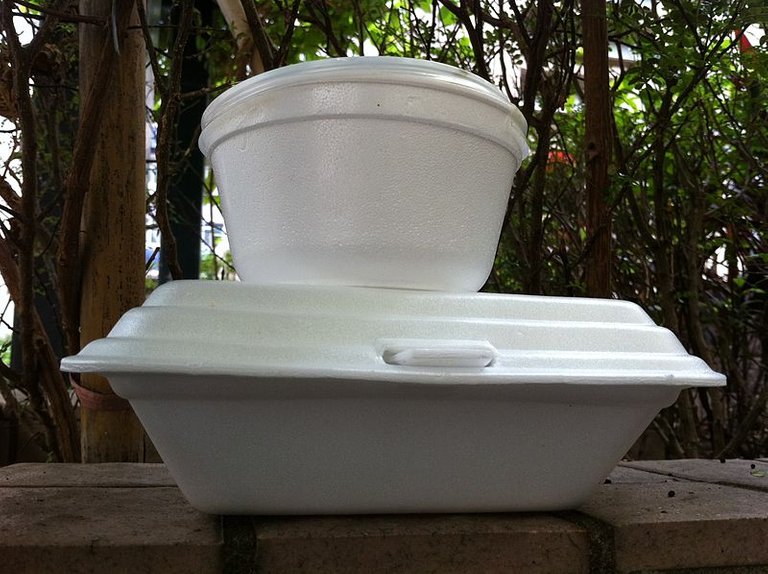Sunlight and oxygen to recycle polystyrene
Polystyrene is a very versatile material, it is a thermoplastic polymer that we know very well, since it is widely used for the production of a wide variety of consumer products, such as a hard and resistant plastic used for the production of containers, electronic articles and toys, among others, but it is also manufactured in the form of foamed plastic, a form that is highly valued in various sectors since it provides an insulating and padding material, ideal for use as thermal and acoustic insulation in the construction industry, for make lightweight containers for food, and many other uses. Therefore, the chemical recycling of this material is a very necessary method to reduce pollution by this type of plastic.

Polystyrene is a very common material, therefore it generates a lot of waste. Source:Wikimedia.org.
And in this regard, a group of Chemists from Cornell University has recently reported having developed a method to use light and oxygen to recycle polystyrene, converting it into benzoyl products, mainly benzoic acid, using a controlled photooxidative degradation method. through a catalyst.
This process represents an important step towards the recycling and efficient use of this type of material, since, as I mentioned before, it is an almost ubiquitous product, we get it in many products, from egg cartons, food containers, glasses, utensils kitchen, vehicle parts and many other products, therefore this material represents almost a third of plastic pollution. And furthermore, the benzoic acid produced in the reaction is widely used in various laboratories, and is also used in the production of fragrances and as a food preservative.

Polystyrene is used in many containers, which is why its waste is very abundant. Source: Wikipedia.org.
The work of this research group was recently published in the Journal of the American Chemical Society, and in it they describe their method based on the use of FeCl3 as a catalyst in the photooxidative degradation of polystyrene, through which, when irradiated with white light, the system reaction, in an atmosphere rich in oxygen, a chlorine radical is generated that promotes degradation by extracting hydrogen atoms from the polymer structure, which degrades high molecular weight polystyrene (>90 kg/mol ) to <1kg/mol, yielding 23% benzoyl products.

General scheme of the polystyrene degradation system. Source: image made in powerpoint, the image of polystyrene is in the public domain.
Basically, the experiment consisted of loading a vial with polystyrene and then adding a solution of FeCl3 in acetone and a stirring bar. The vial was sealed by providing an inlet to provide an air flow to the reaction medium. Then the vial was placed in a photoreactor made on a 3D printer, and this system irradiated with white light placed at 3 cm. The process was terminated at the time desired by the researcher, then the products obtained were quantified by gas chromatography, through which different benzoyl products were detected, mainly benzoic acid.

General scheme of the reaction. Source: image made in powerpoint.
With this method, the researchers evaluated the degradation of three products, white coffee cup lids, transparent lids and polystyrene foam, verifying that they could degrade effectively, and finding that the black lids did not do so efficiently, arguing that perhaps the dyes Blacks hinder the process. However, they were able to show that the method works very well with commercial samples of polystyrene.
The system currently used to recycle this polymer requires heat to melt it and then process it, so it consumes a lot of energy that essentially comes from mobile sources, so recycling this polymer using sunlight would provide a much more environmentally friendly method. .
The research team also optimized the process to perform it on a larger scale, using LED lamps and a larger photoreactor, finding similar larger-scale efficiency to smaller-volume experiments, demonstrating the scalability and possible commercialization of the method; but they stated that they will continue to optimize some variables to make it even more efficient and treat large flows of plastic waste.
We hope that the method can soon be applied on a large scale, thereby reducing the large volume of polystyrene waste that pollutes our soils and oceans every year, and can be used to produce a valuable product instead of just becoming waste.
Thanks for coming by to read friends, I hope you liked the information. See you next time.
Excelent post and great solution for the environment.

Thanks for sharing.
!1UP
Thanks friend, I'm glad you appreciated it, it would really be a great solution for the environment. Thanks for reading, cheers!
You have received a 1UP from @lipe100dedos!
@stem-curatorAnd they will bring !PIZZA 🍕
Learn more about our delegation service to earn daily rewards. Join the family on Discord.
Many thanks!